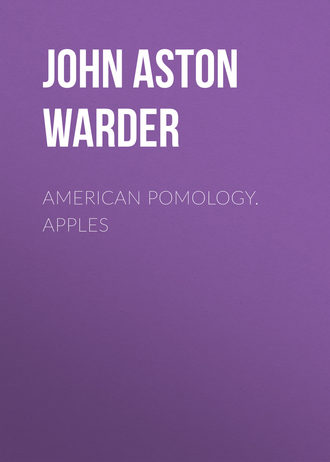 полная версия
полная версияПолная версия
American Pomology. Apples
Tree vigorous and productive in most situations where cultivated, but is not much planted in the West.
Fruit rather small, regular, and usually flat, though sometimes conical; Surface smooth, green; Dots whitish, with green bases.
Basin rather shallow and wavy; Eye large, closed.
Cavity wide, regular and brown; Stem long and stout.
Core closed, regular, meeting the eye, containing numerous angular, acuminate brown seeds; Flesh greenish-white, breaking, tender, juicy and fine grained; very sweet, and valued for baking and market; those who do not admire sweet apples would hardly consider it second rate.
Season from December to February, or March.
Haskell's SweetFound in the orchard of Dr. Geo. Haskell, at Rockford, Illinois.
Fruit large, flat, regular; Surface green, bronzy; Dots numerous, large, white.
Basin deep; Eye small, closed.
Cavity deep, acute, wavy; Stem short.
Core closed; Seeds numerous, plump; Flesh yellow, juicy; Flavor sweet, rich; Quality very good; Use, baking; Season August, September.
A practical test at the table of mine host must convince any one that either the apple or the cook, or both, are eminently deserving. This is supposed to be the Massachusetts variety of the same name.
Hay BoysI do not know where this summer apple was produced, or christened with its peculiar cognomen; Specimens received from H.N. Gillett, Lawrence Co., Ohio.
Fruit large, oblate, regular or slightly angular; Surface pale yellow; Dots numerous, dark, prominent.
Basin wide, abrupt, wavy; Eye medium, closed.
Cavity wide, folded, green; Stem long.
Core very wide, flat, open, clasping the eye; Flesh yellow, fine grained, breaking; Flavor sweet; Quality good, to very good; Use, table and baking; Season, August.
Lancaster Sweet
Fig. 55.—LANCASTER SWEET.
Origin unknown, grown in Central Ohio, where it is much admired for baking and apple butter.
Fruit medium, regular, oblate, slightly conical; Surface green; Dots scattered, dark, minute.
Basin medium, regular; Eye small, closed; Segments of calyx long and reflexed.
Cavity wide, wavy; Stem very short and small.
Core medium, regular, closed, meeting the eye; Seeds numerous, dark, plump; Flesh greenish-white, tender, fine grained, juicy, rich; very sweet.
Quality not first rate, except for cooking; Season September and October.
London Sweet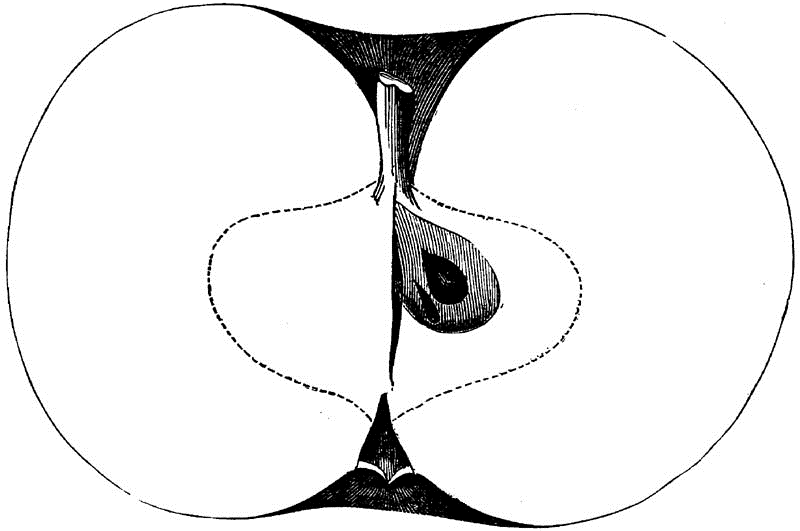
Fig. 56.—LONDON SWEET.
This vigorous, upright, and productive tree is supposed to have had its origin near Dayton, Ohio, whence it has been largely disseminated, giving entire satisfaction to all of its planters. Foliage abundant, and quite dark colored.
Fruit always fair, regular, flat, and of large size; Surface smooth, pale yellow, with scattered dots that are often colored.
Basin abrupt, regular, often having concentric cracks; Eye small and closed.
Cavity wide, regular; Stem short, rather thick.
Core medium width and closed, clasping the eye; Axis very short; Seeds variable, some being plump and some imperfect; Flesh yellowish-white, breaking, rather dry, but very sweet; Quality good; and considered by some persons the very best baking apple of its season, which is from November to January or later.
Mountain SweetMOUNTAINEERFrom Pennsylvania; exhibited by Joel Wood, before the Ohio Pomological Society.
Fruit large, beautiful, but too delicate for transportation, oblate; Surface smooth, light, yellow; Dots minute.
Basin wide, wavy; Eye small, closed.
Cavity deep, acute, wavy; Stem short, slender.
Core wide, open, dark, clasping the eye; Seeds numerous, pointed; Flesh white, breaking, very tender, fine grained, juicy; Flavor sweet; Quality good to very good; Use, table, baking; Season, December.
A rival of Broadwell or Ladies' Sweeting.
Munson SweetORANGE SWEET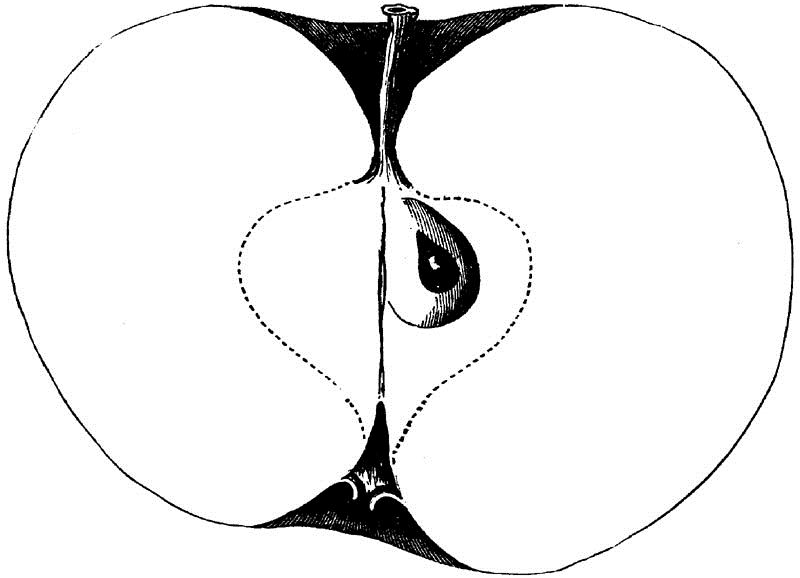
Fig. 57.—MUNSON SWEET.
This New England variety is considered quite promising in its new western homes, where, however, it is not yet widely known or tested. Tree vigorous, spreading, and productive when established; said to be a regular bearer.
Fruit medium, flat; Surface smooth, green, becoming yellow; Dots minute.
Basin small, abrupt, often folded or plaited; Eye medium, closed.
Cavity wide, wavy, green; Stem medium or short.
Core small, closed; Seeds plump; Flesh yellowish-white, fine grained, tender, juicy; Flavor very sweet; Quality nearly first rate; Valuable for baking; Season early winter.
Snepps'JNO. SNEPPS'
Fig. 58.—SNEPPS'.
This fine apple is believed to have originated at Edinburgh, Indiana, and was brought to the notice of the State Society by the orchardist whose name it bears, and by whom it has been distributed. As it appears to be distinct from any known fruit, it is here described. Tree vigorous and sufficiently productive.
Fruit above medium, almost large, flat, generally regular.
Surface nearly smooth, of a dull green, becoming pale yellow, with numerous dark dots, that often give it a gray appearance.
Basin rather shallow, sometimes folded or wavy; Eye large and closed; Segments of the calyx coarse.
Cavity acute, regular, rather deep; Stem medium to short, stout.
Core large but closed; Seeds numerous, pointed, brown; Flesh yellowish, breaking, fine grained, juicy; Flavor very rich, and agreeably sweet when ripe; Use, fine dessert fruit, and good for cooking; Season, December to March.
Superb SweetThis variety is worthy of more attention than it has received; native of Massachusetts, where it is a vigorous and productive tree. Its period of maturity makes it less valuable than it would otherwise be.
Fruit above medium, roundish; Surface smooth, of a pale yellow color, often shaded with red.
Basin rather shallow, broad; Calyx large, open.
Cavity regular, deep; Stalk long.
Flesh white, fine grained, tender, juicy; Flavor rich, sweet.
Cole gives its season as September and October, in Massachusetts.
Trumbull SweetFENTON SWEETThis is another fine white sweet apple, originating in Ohio, which, notwithstanding its beauty, is less esteemed on account of its season, but its productiveness makes it valuable for stock-feeding. Tree vigorous, spreading, productive, and an early bearer.
Fruit above medium, regular, flat; Surface very smooth, pale yellow, or white, resembling ivory; Dots scattering, minute.
Basin deep, regular; Eye large, rather open.
Cavity deep; Stem short.
Core closed; Seeds numerous, plump; Flesh white, fine grained, breaking, juicy; Flavor very sweet; Quality very good; Use, baking and stock; Season September and October.
CLASS I.—FLAT APPLESORDER I.—REGULARSECTION 1.—SWEETSUB-SECTION 2.—STRIPED Baltimore.—[Of Elliott.]FLUSHING SPITZENBERG, OF NORTHWEST.—CABLE'S GILLIFLOWER.—ROYAL PIPPIN IN ILLINOIS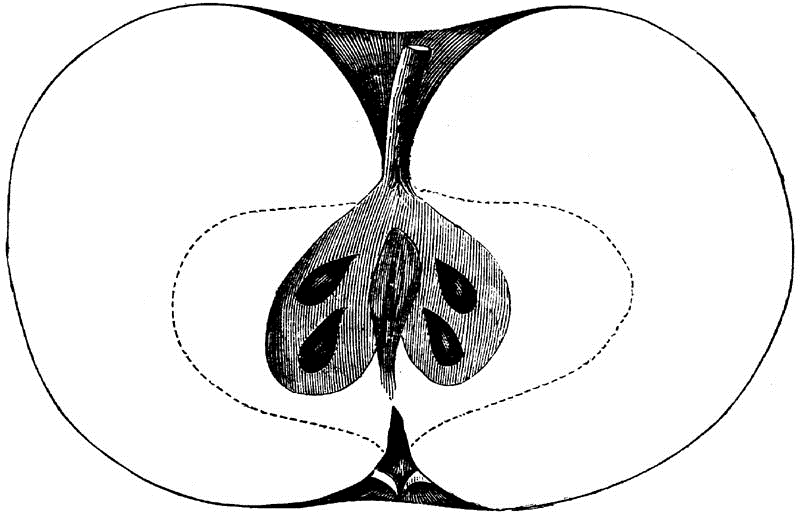
Fig. 59.—BALTIMORE.
The origin of this very satisfactory second rate fruit is unknown, though it is extensively cultivated in western orchards, especially in the lake country, for it is scarcely known within the Ohio river fruit region.
Tree thrifty, sufficiently vigorous but with slender growth, very productive, spreading.
Fruit medium, regular, oblate, almost round in some specimens, Surface smooth, red, striped with deep red and often covered with whitish or gray markings that give it a blue appearance like a bloom; Dots scattered, large, yellow or fawn color.
Basin shallow, regular; Eye small, closed.
Cavity wide, regular, brown; Stem short to medium.
Core large, closed; Seeds numerous, plump; Flesh yellow, fine grained, juicy, almost sweet, aromatic, lacking character; Of second quality, but valuable for market; December and January; Not disposed to rot, does not show bruises.
ButterFULKERSON'S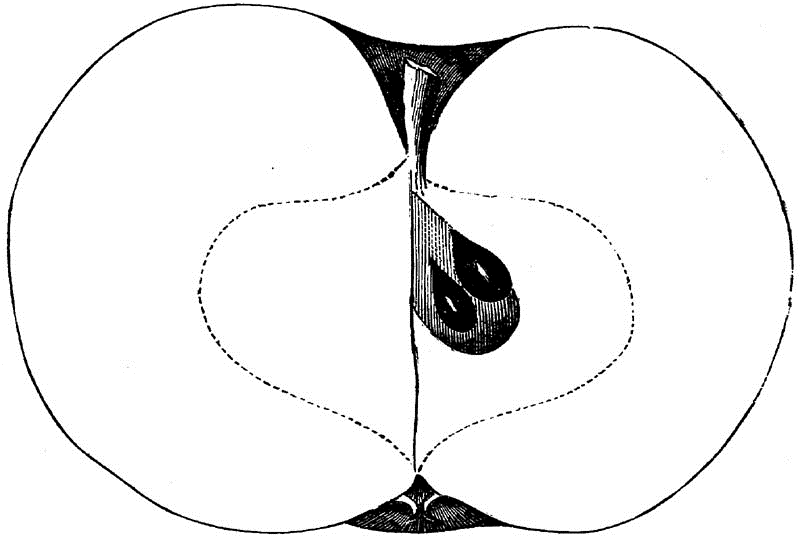
Fig. 60.—BUTTER.
The origin of this fruit has not been definitely traced, and though not very widely diffused, it is a prime favorite with its acquaintances, and the lovers of rich apple-butter.
Fruit small, very regular, oblate; Surface very smooth, and so covered with mixed red as rarely to show the yellow ground color; upon this are laid darker stripes of deep red; Dots minute and inconspicuous.
Basin medium, regular, or folded; Eye rather large, closed.
Cavity acute, regular, brown; Stem of medium thickness, rather long.
Core wide, large, closed; with large, plump, pointed seeds; Flesh yellow, tender, fine grained, juicy; with a sweet, rich and aromatic flavor. Valuable for stock and for apple-butter; Season, October to January.
Conant's Red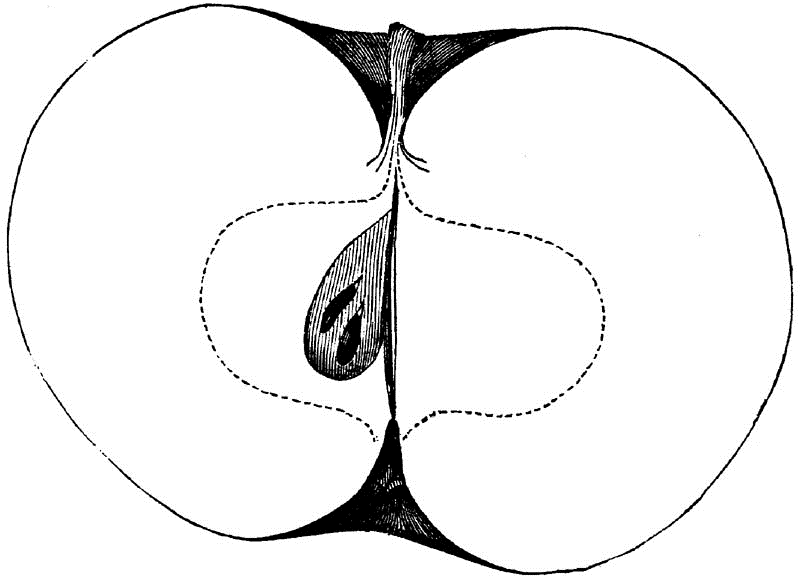
Fig. 61.—CONANT'S RED.
This variety is cultivated in southern Ohio and adjacent regions, to which it has been distributed by the venerable Pomologist, H.N. Gillett, of Quaker Bottom, to whom the author is under many obligations for valuable information connected with the fruits of that productive region.
Fruit full medium, regular, oblate, and sometimes nearly round.
In appearance this apple is not very prepossessing, as the surface is rough, the yellow ground is obscured by mixed red, upon which are red stripes and streaks of russet; dots are numerous, minute, indented, yellow or fawn colored.
Basin rather deep, abrupt, regular or wavy; Eye small, closed.
Cavity wide, wavy or regular, green; Stem medium to long, slender.
Core large, regular, closed; Seeds numerous, some are imperfectly developed; Flesh yellow, fine grained, juicy; flavor sub-acid to sweet, very aromatic, agreeable, fitting it admirably for a dessert fruit, as which it is nearly first rate. Season from September to December.
Connett Sweet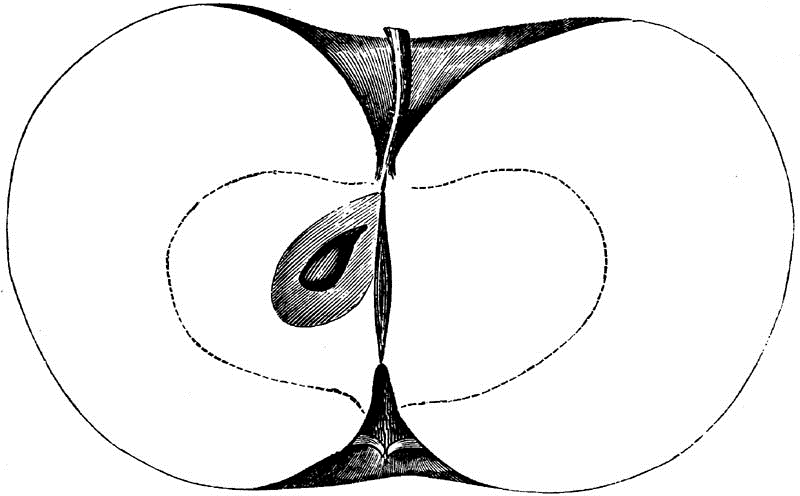
Fig. 62.—CONNETT SWEET.
The tree grows vigorously, is upright and productive, bearing early. Its origin I have not learned, but procured the specimens from my valued friend, Jno. C. Teas, of Raysville, Indiana.
Fruit of good size, regular, flat; Surface rather rough, dull red, with indistinct stripes; Dots few, dark, sunken.
Basin not deep, wide, regular; Eye rather large, closed.
Cavity wide, regular, brown; Stem medium to long.
Core wide, closed; Seeds of medium size; Flesh compact, yellow, fine grained; Flavor very sweet; Quality very good; Season, December to March.
GranniwinkleThis is supposed to be the famous cider apple of New Jersey, described by Coxe, except that the form is different; it has as good qualities for making a rich cider; specimens obtained from W.C. Hampton.
Fruit small, oblate, regular; Surface dull red, striped purple; Dots numerous, yellow.
Basin wide, regular; Eye large, open.
Cavity wide, regular, brown; Stem long, inclined.
Core medium, round, regular, closed, meeting the eye; Seeds numerous, angular, plump; Flesh yellowish-white, firm, tough; Flavor sweet; Use, cider; Season, winter.
Jersey SweetAMERICAN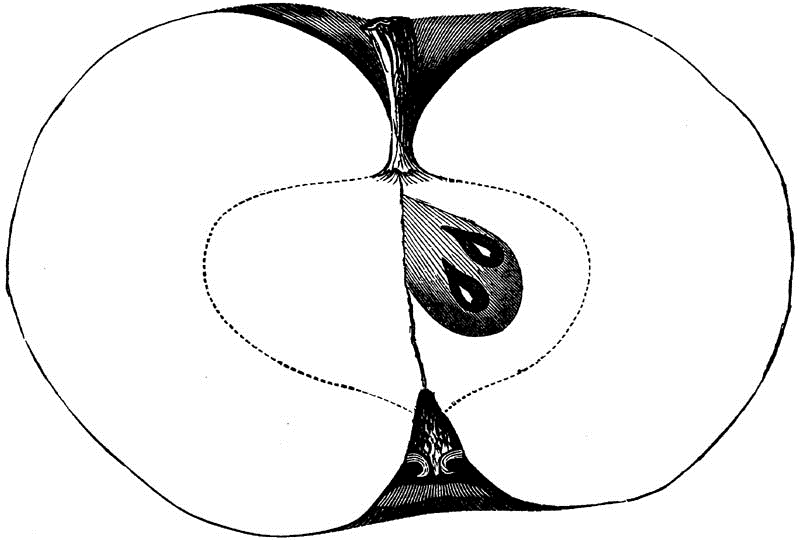
Fig. 63.—JERSEY SWEET.
In some parts of the country this is a favorite baking apple, but its great productiveness renders it small, and makes it rather a stock apple. Tree vigorous, round-headed; Shoots short-jointed and red; Foliage abundant.
Fruit medium, regular, globular-oblate, sometimes rather conical, (according to Elliott & Downing, roundish-ovate, but the drawing given by the latter is globular);Surface smooth, yellow, nearly covered with red, mixed, striped and splashed carmine, more or less distinctly; Dots generally minute.
Basin medium to wide, regular; Eye small, generally closed.
Cavity wide, regular or wavy, rather deep, brown, and in Michigan often green; Stem medium to long, green.
Core wide, regular, partially open in some specimens, but generally closed; Seeds numerous, wide, pointed, plump; flesh pale yellow, tender, fine grained, juicy; Flavor very sweet, aromatic and rich; Use, the dessert, for those who like sweet apples, but especially valued for baking and for feeding stock. Season August to October.
Moore's SweetingRED SWEET PIPPIN.—BLACK SWEET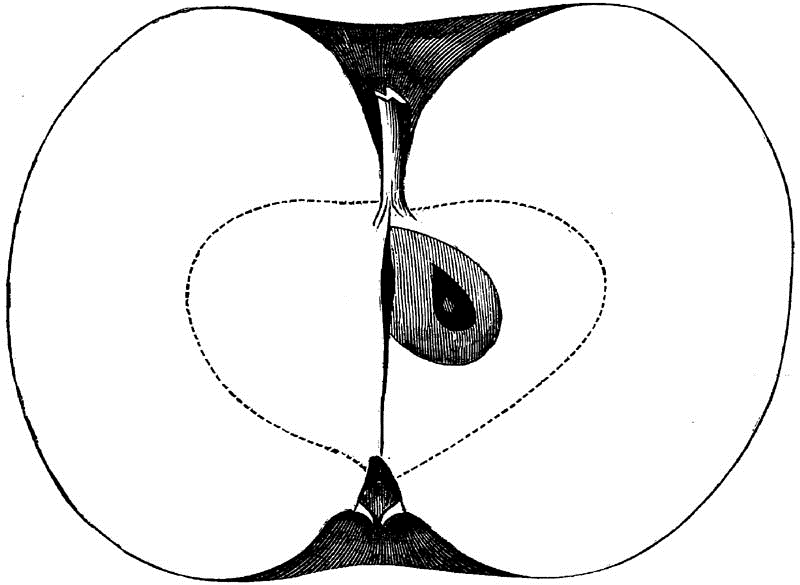
Fig. 64.—MOORE'S SWEETING.
This valuable winter sweet apple is much cultivated throughout the West on account of its productiveness, and the amount of nutriment it furnishes to both man and animals. Tree vigorous, healthy, spreading, round, with branches sufficiently open; Shoots dark olive; Foliage large, dark green.
Fruit medium to large, globular-oblate, regular; Surface smooth, greenish-yellow, covered with dull red in confused stripes and shaded with gray that gives the fruit a purple hue; Dots minute and few; Skin thick.
Basin wide, wavy or folded; Eye medium, closed.
Cavity wide or acute, deep, green or brown; Stem short, rather stout.
Core small, closed; Seeds numerous, plump, pale; Flesh yellow, dry, firm; Flavor very sweet; Quality inferior, for the dessert; Use, baking, market, stock, cider; Season from December to March and later, keeping very sound.
Putnam SweetOriginated near Marietta, Ohio.
Fruit large, flat, regular; Surface smooth, mixed, splashed and striped deep red; Dots numerous, large.
Basin wide, shallow, regular; Eye small, closed.
Cavity wide, regular; Stem short.
Core roundish, flattened, open, clasping the eye; Seeds numerous, pointed, pale; Flesh tender; Flavor sweet; quality very good; Use, kitchen, stock; Season August, September.
Richmond
Fig. 65.—RICHMOND.
Described by F.R. Elliott, author of American Fruit Growers' Guide, and named for our mutual friend, D.C. Richmond, near Sandusky, Ohio, who found it in an old seedling orchard with several other good varieties. The seeds were supposed to have been brought from the old French orchards of Canada. Tree large, vigorous, productive, and would appear to have been hardy.
Mr. Elliott says:
"Fruit large; Form roundish, occasional specimens have one side a little enlarged; Color light yellow ground, mostly or quite overspread with light and dark red stripes, many dots or specks of light russet; Stem varying, mostly short, slender; Cavity deep, open, regular, a little brownish at bottom; Calyx large, segments long; Basin deep, open, uniformly furrowed; Flesh white, tender, juicy, delicate, sweet; Core medium; Seeds large, full; Season October to December."
Sweet Vandervere
Fig. 66.—SWEET VANDERVERE.
This is another western favorite with the admirers of sweet apples. Tree sufficiently vigorous, healthy, and productive; twigs slender, like those of the true Vanderveres.
Fruit of good size, from full medium to large, regular, oblate, and resembling the Pennsylvania Vandervere; surface very smooth, yellow, shaded with mixed red, and striped with dull or dark red; Dots yellow, scattered, indented.
Basin abrupt, wide, deep, regular; Eye small, closed.
Cavity sometimes wide and regular, or acute; Stem long, slender.
Core regular, heart-shaped, closed; Seeds medium to long, angular; Flesh firm, breaking, yellow; Flavor sweet, pleasant; Quality not first rate, valued for baking and for stock; Season December and January.
CLASS I.—FLAT APPLESORDER I.—REGULARSECTION 1.—SWEETSUB-SECTION 3.—RUSSETNoneCLASS I.—FLAT APPLESORDER I.—REGULARSECTION 2.—SOURSUB-SECTION 1.—SELF-COLOREDBetter Than GoodJUICY BITELike our standard authority, I am obliged to quote from the American Pomological Society's Transactions. Origin uncertain, (Elliott says from Pennsylvania); Tree thrifty, rather slender, very productive.
Fruit medium, oblate; Skin pale yellow, with a few brown dots.
Basin large and open; Calyx closed.
Cavity broad; Stem short.
Flesh yellowish, very tender, juicy; Flavor mild, pleasant, sub-acid; November to January.
Bohanon
Fig. 67.—BOHANON.
This apple was brought into notice by Lewis Sanders, that veteran agriculturist of Kentucky, who was equally remarkable as a planter of choice fruits, and breeder of fine cattle. Mr. Elliott thinks this variety may have had its origin in Virginia. Tree moderately vigorous and productive.
Fruit full medium, regular, oblate, rarely inclined to be angular, sometimes slightly conical; Surface very smooth, whitish, or waxen, occasionally blushed with pale carmine, making it very beautiful; Dots minute.
Basin abrupt, narrow, folded, wavy and irregular; Eye closed; Segments reflexed.
Cavity acute, brown; Stem rather long.
Core regular, small, pyriform, closed, clasping the eye; Seeds small, compressed; Flesh white, breaking, fine grained, juicy, sub-acid; Quality very good and preferred as a dessert fruit to the Maiden's Blush which it much resembles without having the peculiar flavor of that variety.
CornfieldA southern variety received from J.S. Downer & Son.
Fruit medium, roundish-oblate or cylindrical, truncate, regular; Surface smooth, yellow, covered with mixed deep red, striped; Dots numerous, minute.
Basin deep, abrupt, regular, leather-cracked; Eye small, open.
Cavity wide, acute; Stem short.
Core round, regular, closed, hardly clasping; Axis short; Seeds numerous, plump; Flesh yellow, fine grained, tender, rather dry; Flavor sub-acid; Quality good; Use, table; Season, December.
Cracking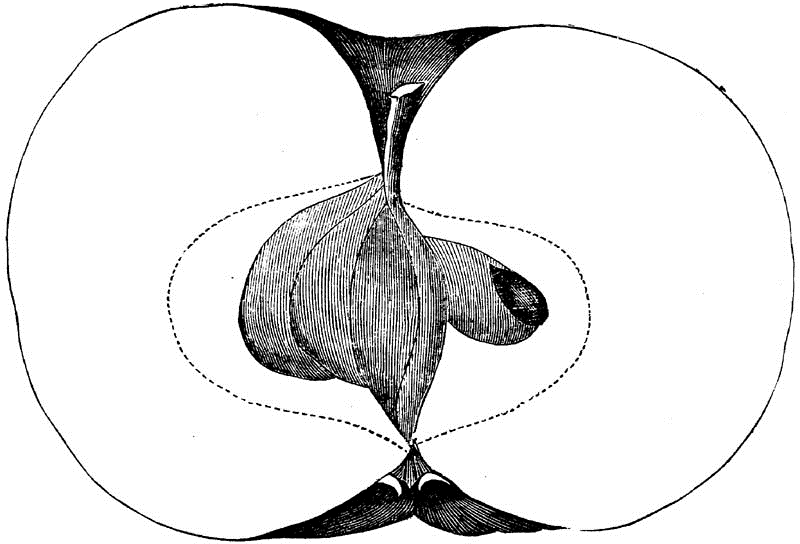
Fig. 68.—CRACKING.
This variety had its origin in the eastern part of Ohio. The tree is a strong grower and productive.
Fruit large, oblate, somewhat uneven and irregular, but handsome; Surface smooth, greenish-yellow until ripe, when it is often tinged with red; Dots numerous, minute, indented and green.
Basin wide, folded; Eye medium, closed.
Cavity acute, wavy, brown; Stem short, rather stout.
Core wide, open, clasping the eye; Seeds large, pointed, dark; Flesh yellow, breaking, juicy; Flavor sub-acid; quality nearly first rate; Use, kitchen and table; Season September and October.
Cranberry PippinThis is a beautiful apple which originated near Hudson, New York. Tree vigorous, very productive.
Fruit large, flat, regular; Surface very smooth, bright, clear yellow, with a shining scarlet cheek; Dots minute.
Basin wide, regular or wavy; Eye small, short, closed.
Cavity wide, wavy; Stem medium.
Core small, oval, just meeting the eye; Axis short; Seeds numerous, long; Flesh white, breaking, juicy; Flavor mild, sub-acid; Quality very good for cooking, not for dessert; Season November to February in New York.
DaltonSpecimens from Mr. Warren, of Massachusetts. Origin and history unknown.
Fruit medium, flat, uneven; Surface smooth, yellowish-green, becoming greasy; Dots scattered, green.
Basin medium, folded; Eye medium, closed.
Cavity deep, pointed; Stem medium.
Core medium, wide, closed, clasping the eye; Seeds large; Flesh, greenish-white, tender, juicy; Flavor sub-acid; Quality good; Use kitchen, table; Season September.
Not particularly desirable.
Early Harvest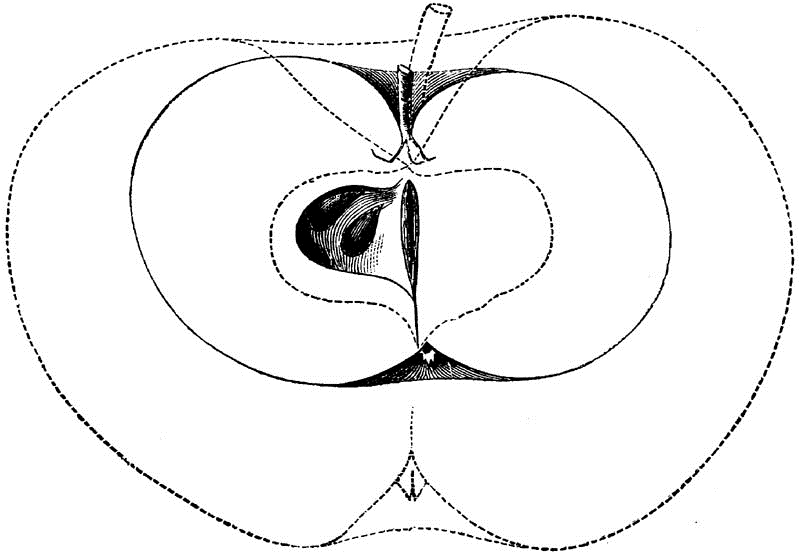
Fig. 69.—EARLY HARVEST.
This American apple has long been a prime favorite in the orchard, especially when planted for family use, since it is of excellent quality for table as well as in the kitchen. For the commercial orchard, however, it is falling into disfavor with the market men, because of its uncertainty, and its proneness to be defective on some soils.
Tree spreading, healthy and vigorous; the limbs are very strongly attached to the trunk by a woody enlargement at their base, and the pale olive twigs are remarkable for their peculiar mode of production in twos and threes from a common origin.
Fruit medium, regular, oblate, sometimes almost round, as described by Downing, but this is rare in the West, where the oblate form prevails. Surface smooth, clear, waxy yellow, very rarely blushed; Dots numerous, minute, green.
Basin regular, narrow, abrupt; Eye small, closed.
Cavity wide, regular; Stem short.
Core round, closed, not meeting the eye; Seeds large, pointed; Flesh tender, breaking, juicy, acid to sub-acid, agreeable; Of first quality for table or kitchen during the month of July.
Faust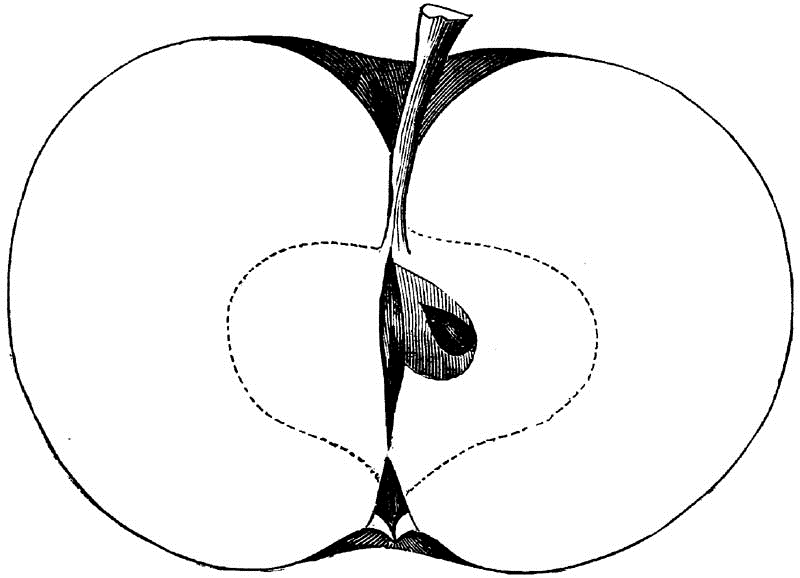
Fig. 70.—FAUST.
This very nice apple, received from S.W. Westbrooke, of Greensboro, N.C., deserves the commendation of its southern admirers.
Fruit regular, globular-oblate, of medium size; Surface smooth, yellow, with a white bloom and sunken white dots.
Basin shallow, folded; Eye small, closed.
Cavity wide, green; Stem medium, to long.
Core wide, closed, scarcely meeting the eye; Seeds angular; Flesh yellow, fine grained; Flavor sub-acid, aromatic, and first quality for table or dessert use, in November or later.
FinleyABBOTT?
Fig. 71.—FINLEY.
This fine fruit originated in Kentucky and is cultivated to some extent in Southern Indiana, where it is considered entitled to the meed of excellence, and preferred to the Early Harvest on the one hand, and to the Maiden's Blush on the other; and in its season, it competes with both, being useful in July for the kitchen, and ripening gradually until September.
Tree large, spreading, vigorous and productive.
Fruit large to very large, regular, globular-oblate, slightly conical; Surface smooth, greenish-yellow, becoming a clear lemon yellow at maturity; Dots minute, gray, scattering.
Basin rather wide, wavy; Eye small, closed; Segments reflexed.
Cavity acute, medium to deep, regular, brown; Stem long, yellow.
Core heart-shaped, regular, closed, clasping the eye; Seeds few, large, plump, and some imperfect; Flesh yellow, breaking, fine grained, juicy, acid, almost first quality; Valuable for kitchen and market; Season August and September.
FinkFINK'S SEEDLINGThis long keeper was brought before the notice of the Ohio Pomological Society many years ago by Mr. Clarke, of Somerset, Ohio. Mr. Elliott considered it the same as Tewksbury Winter Blush, and introduces Fink's Seedling as a synonym of that variety. Others think it a different fruit, among whom is that practical Pomologist, the Secretary of that association, M.B. Bateham, Esq., who has propagated and planted the trees extensively. It was described as Fink's Seedling in the Ohio Cultivator, May, 1847. At the meeting of 1854, the merits and claims of this variety were freely discussed, and the Society named it the Fink, after admitting that it was an original seedling, as stated by Mr. Fink, in whose seedling orchard it had originated.
Tree of strong upright growth, a profuse and annual bearer.
Fruit small, regular, roundish-oblate; Surface very smooth, polished, greenish-yellow, blushed with brownish-red; Flesh whitish, breaking, juicy, mild sub-acid; remarkable for its keeping qualities, remaining sound until the second season, and has been shown in May after having been kept over two winters.
Fulton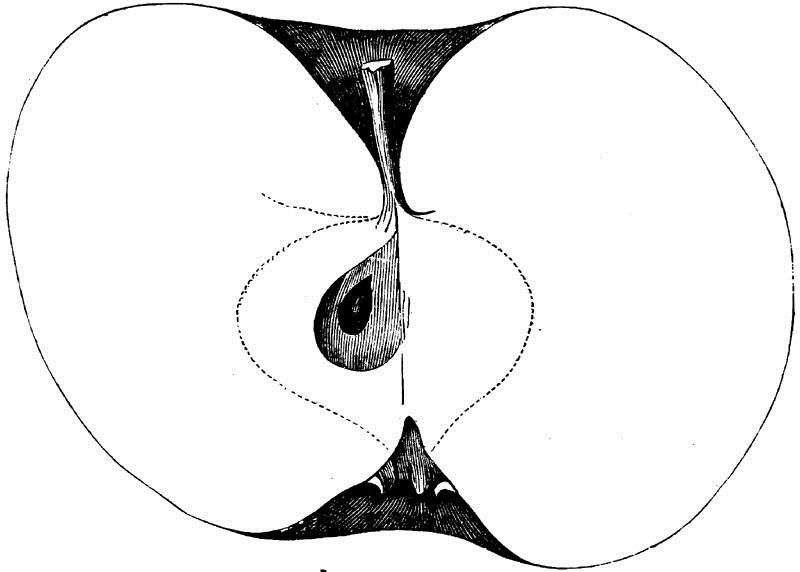
Fig. 72.—FULTON.



